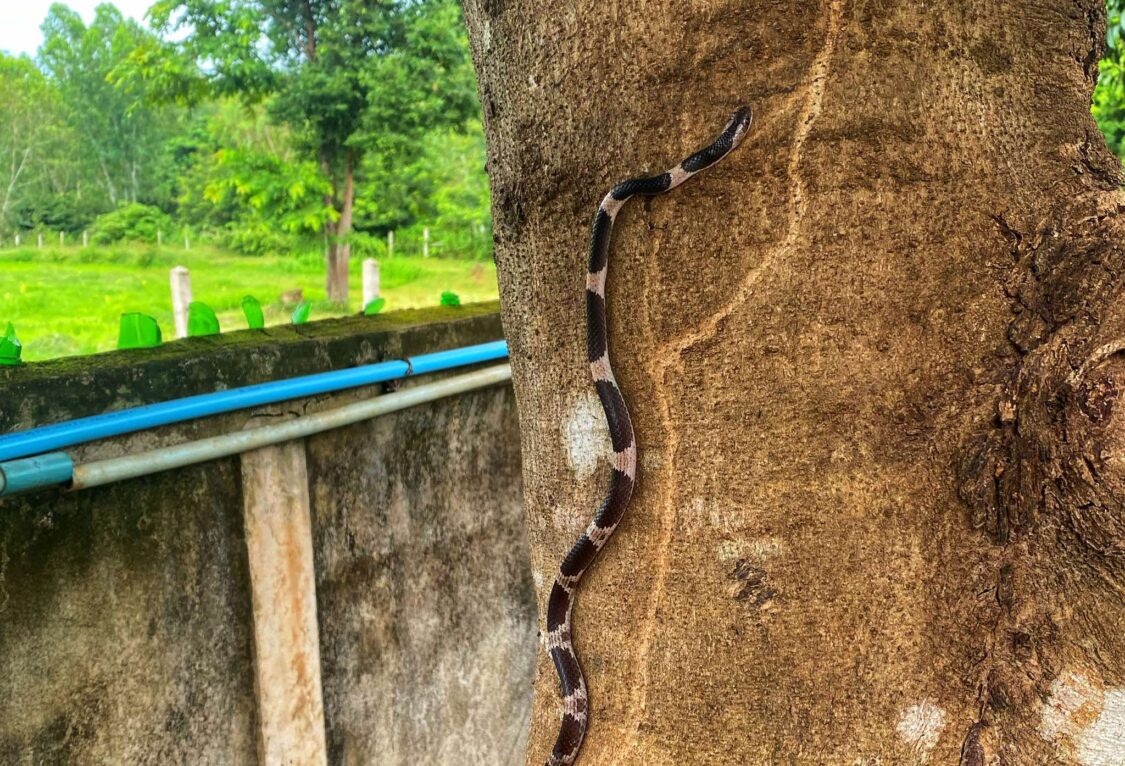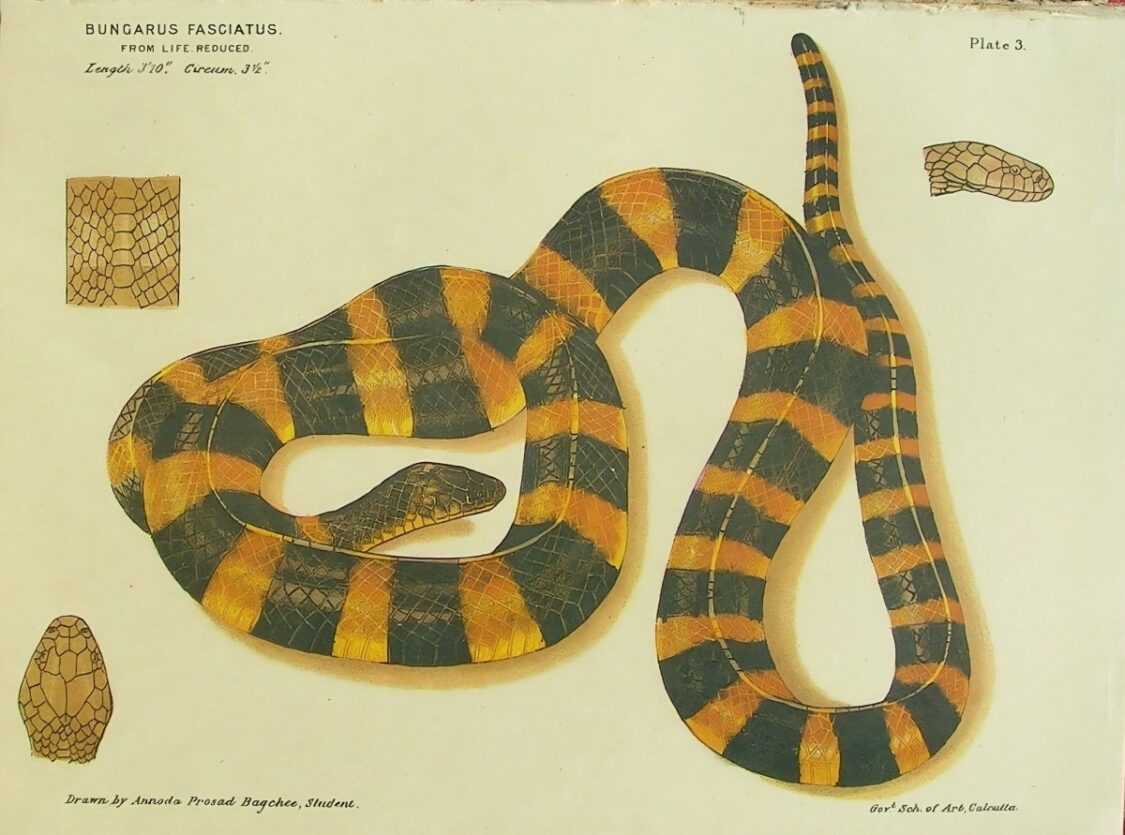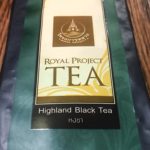Banded Krait vs. Wolf Snake in Thailand

Seen Above: A Malayan banded wolf snake climbing up a tree in Sakon Nakhon province, Northeast Thailand.
Most people in Thailand are fearful of snakes, which should come as no surprise. The Kingdom is home to many of the world’s most venomous snakes. I was reminded of this recently when a banded snake slipped into our house and was discovered under a sofa by our Jack Russell.
My wife shrieked in fear, because she thought the snake was the deadly banded krait. But on closer inspection I saw that it was not a krait, but the harmless Malayan banded wolf snake.
It’s important to note that the overwhelming majority of snakes you might encounter in Thailand are non-venomous, but it still is good to know how to identify the a dangerous snake versus a somewhat similar looking harmless relatives.
So, today let’s compare the banded krait (Bungarus fasciatus) and the Malaya banded wolf snake (Lycodon subcinctus). Although both are marked by distinctive banding patterns, these snakes differ significantly in terms of size, behavior, and threat level.
The Deadly Banded Krait in Thailand
The banded krait is one of the most iconic venomous snakes in Southeast Asia, including Thailand. It is recognized by its bold black and yellow bands (the hue ranging from a deep yellow to a pale cream). The yellow bands can be wider or narrower than the black. The snake can grow to a considerable size, ranging from 1.5 to 2.5 meters in length.
Historically, the banded krait has held a place of both reverence and fear within Thai culture. Its presence in folklore, especially in rural communities, symbolizes the mysterious and often dangerous world of venomous creatures that inhabit the forests and countryside.
The snake’s neurotoxic venom, which can cause paralysis and even death, made the Thais rightly fearful. However, the banded krait is generally shy and non-aggressive. Bites are rare and usually occur only when the snake is provoked or accidentally stepped on, particularly during nighttime when it is more active.
The banded krait plays an important role in controlling the population of rodents and other small animals in Thailand. It typically inhabits areas near water sources, such as rivers and wetlands, and is often found hiding during the day in crevices, under logs, or within piles of debris.

The Malaya Banded Wolf Snake in Thailand
In contrast to the banded krait, the Malaya banded wolf snake is a smaller, non-venomous species. However, don’t try distinguishing this snake by size alone, as you could be seeing a young (not fully grown) banded krait.
Growing between 40 and 80 centimeters in length, the wolf snake exhibits a banded pattern. The bands are usually black or dark brown interspersed with white or yellow. These bands tend to be irregular, giving the wolf snake a somewhat less uniform appearance compared to the clean, alternating bands of the banded krait.
The wolf snake’s smaller size and less vivid patterning can make it difficult to distinguish from the banded krait, especially for the untrained eye. However, the wolf snake’s head is narrower and less distinct from its body, which helps to differentiate it from the more robust head of the krait.
The wolf snake’s behavior is also distinct. It is often found near human dwellings, particularly in moist environments like gardens, where it hunts small lizards, frogs, and insects.
While the wolf snake is non-venomous, it can be defensive and may attempt to bite if handled. Encounters with humans are common, given that it likes to dwell in human-modified environments. But the snake’s presence is often appreciated, since it helps control pest populations, though its similarity in appearance to the krait can occasionally cause unnecessary panic.
So, to summarize, here are the identifying characteristics of these two Thai snakes.
Identifying a Banded Krait vs. a Malayan Banded Wolf Snake
Banded Krait
• Size: Large, 1.5 to 2.5 meters in length.
• Color Pattern: Alternating black and yellow (or pale cream) bands that are rather uniform in placement
• Head Shape: Broad head, distinct from the neck.
• Body Shape: Thick and cylindrical with a short, blunt tail.
• Behavior: Shy, nocturnal, highly venomous but non-aggressive.
Malayan Banded Wolf Snake
• Size: Small, 40 to 80 centimeters in length.
• Color Pattern: Alternating black/dark brown and white/yellow bands; bands are irregular in width and placement.
• Head Shape: Narrow head, less distinct from the body.
• Body Shape: Slender with a tapered tail.
• Behavior: Nocturnal, non-venomous, may bite but harmless to humans.
- The 1st English Dhamma Talk Project, Sakon Nakhon Thailand - July 8, 2025
- Affirmations in Buddhism & Thailand - June 7, 2025
- Speak Thai Naturally Without the Gymnastics - April 20, 2025




